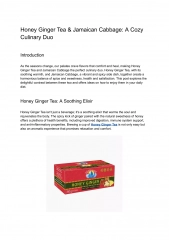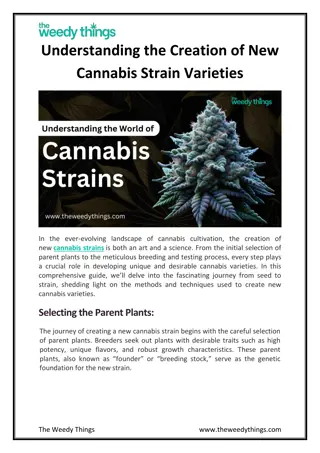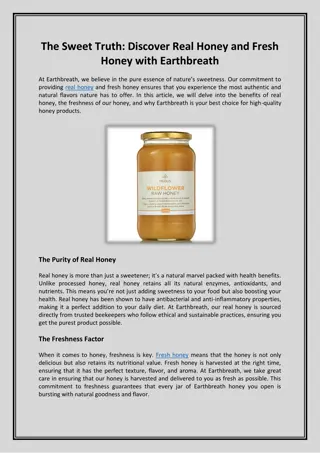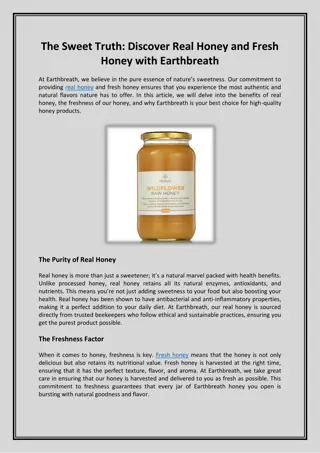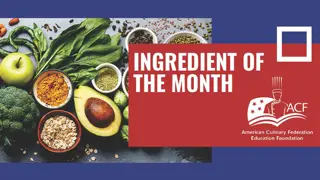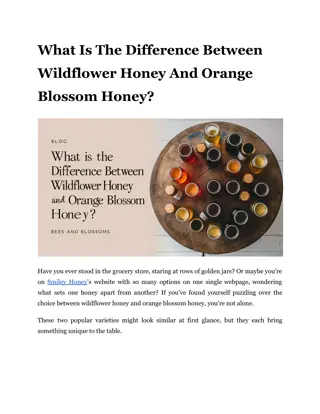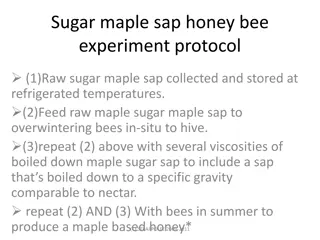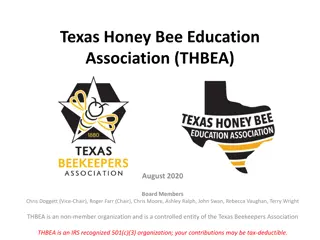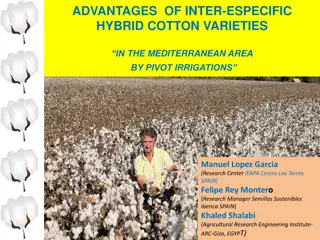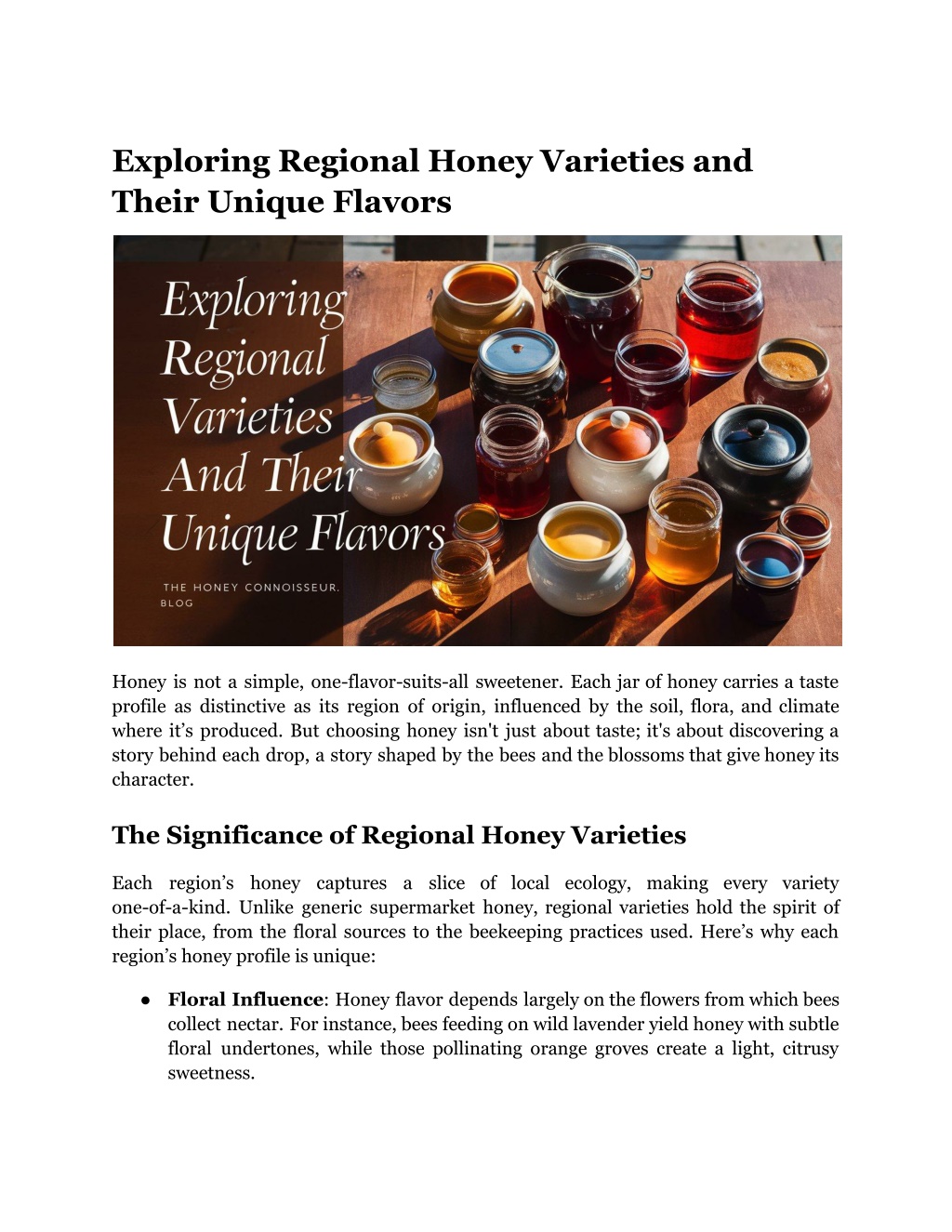
Exploring Regional Honey Varieties and Their Unique Flavors
Explore the unique flavors of regional honey. Learn what makes each variety special and how to choose the perfect honey for your taste.n
Download Presentation

Please find below an Image/Link to download the presentation.
The content on the website is provided AS IS for your information and personal use only. It may not be sold, licensed, or shared on other websites without obtaining consent from the author. Download presentation by click this link. If you encounter any issues during the download, it is possible that the publisher has removed the file from their server.
E N D
Presentation Transcript
Exploring Regional Honey Varieties and Their Unique Flavors Honey is not a simple, one-flavor-suits-all sweetener. Each jar of honey carries a taste profile as distinctive as its region of origin, influenced by the soil, flora, and climate where it s produced. But choosing honey isn't just about taste; it's about discovering a story behind each drop, a story shaped by the bees and the blossoms that give honey its character. The Significance of Regional Honey Varieties Each region s honey captures a slice of local ecology, making every variety one-of-a-kind. Unlike generic supermarket honey, regional varieties hold the spirit of their place, from the floral sources to the beekeeping practices used. Here s why each region s honey profile is unique: Floral Influence: Honey flavor depends largely on the flowers from which bees collect nectar. For instance, bees feeding on wild lavender yield honey with subtle floral undertones, while those pollinating orange groves create a light, citrusy sweetness.
Climate and Soil: Temperature, humidity, and soil composition also play roles. Bees in tropical climates produce honey that s typically sweeter and fruitier, while honey from cooler regions can be more complex and robust. Local Beekeeping Traditions: Sustainable practices like those in small-scale beekeeping often influence the honey's purity and quality. Local beekeepers frequently prioritize the bees health, allowing for more authentic flavors compared to industrialized honey production. An Exploration of Regional Honey Varieties Honey connoisseurs know that each region s honey tells its own story. From Tupelo Honey in USA. to Heather Honey in Europe, these unique varieties are worth savoring. Here s a look at some remarkable regional honeys and their flavor notes. 1. Tree Honey Region: Southeastern United States (Florida, Georgia) Flavor Profile: Smooth and buttery, with floral undertones and a low glycemic index Tupelo, native to the Southeastern U.S., is one of the most sought-after honey varieties worldwide. It has a distinctively light, buttery flavor that s balanced and never overwhelmingly sweet. The rare Tupelo tree blooms only a few weeks each year, making this honey particularly valuable. Unlike many other honeys, Tupelo honey is prized for its stability as it doesn t crystallize due to its unique sugar composition, making it ideal for long-term storage. Challenges: Sustainably harvesting tree honey requires careful timing and respect for the wetland habitats where Tupelo trees grow. Climate change and wetland destruction threaten these habitats, making sustainable production ever more critical. 2. Manuka Honey Region: New Zealand and parts of Australia Flavor Profile: Rich, earthy, and slightly bitter with medicinal undertones Manuka Honey has gained a global reputation for its health benefits due to its high levels of methylglyoxal, an antibacterial compound. Sourced from the nectar of the Manuka bush, this honey has an intense, earthy flavor with a slight bitterness, distinguishing it from sweeter varieties. Many use Manuka honey for its reported health benefits, from soothing sore throats to aiding in wound care.
Challenges: Demand for Manuka Honey has skyrocketed, leading to over-commercialization. Counterfeit Manuka products flood the market, making it challenging for consumers to source genuine honey. Sustainable practices are also under threat due to intensive harvesting pressures. 3. Heather Honey Region: United Kingdom and Western Europe Flavor Profile: Thick, gelatinous texture with a full-bodied, woody flavor Heather Honey, primarily from the UK and parts of Western Europe, is known for its distinctively strong, aromatic flavor with notes of peat and smoke. This honey is derived from the nectar of wild heather flowers and has an unusual consistency, often described as jelly-like. The intensity of Heather Honey makes it ideal for pairing with strong cheeses or using as a glaze for meats. Challenges: Heather moorlands are under constant threat from development, farming, and environmental changes, making it harder to sustain the bees that produce Heather Honey. Additionally, the unique floral sources of heather honey require careful habitat conservation. 4. Sidr Honey Region: Yemen and the Middle East Flavor Profile: Rich and luxurious with a lingering sweetness and spicy undertones Sidr Honey is one of the most expensive honey varieties, sourced from the ancient Sidr trees of Yemen. The honey has a powerful, luxurious flavor with subtle spiciness and a caramel-like sweetness. Its reputed health benefits and the rich history of Sidr trees make it highly prized across the Middle East. Challenges: The production of Sidr Honey is complicated by political unrest and environmental instability in Yemen, making it difficult for beekeepers to maintain traditional harvesting practices. Additionally, counterfeit Sidr honey has flooded the market, undermining the authenticity of the genuine product. Comparing Regional Honey Varieties
Honey Variety Region Unique Flavor Notes Main Challenges Tupelo Honey Southeastern U.S. Buttery, crystallize floral, doesn t Habitat impact loss, climate Manuka Honey New Australia Zealand, Earthy, medicinal undertones slightly bitter, Over-commercialization, counterfeits Heather Honey UK, Europe Western Woody, gelatinous texture smoky, Moorland threats loss, habitat Sidr Honey Yemen, Middle East Spicy, sweetness caramel-like Political counterfeiting unrest, Why Choosing Regional Honey Matters Supporting regional honey varieties goes beyond enjoying unique flavors as it s a conscious choice that helps preserve the environment, sustains local economies, and promotes beekeeping traditions. Environmental Impact: Choosing honey from local or sustainable sources supports conservation efforts in that region. By buying tree honey, for instance, you re indirectly contributing to wetland preservation in the Southeastern U.S., where Tupelo trees thrive. Economic Sustainability: Regional honey often supports small-scale or family-owned beekeeping operations. This helps local economies, providing income to small businesses that invest in sustainable practices. Preservation of Bee Diversity: Many regional honeys rely on specific bee species or subspecies adapted to their local environment. By supporting regional honey, you contribute to maintaining bee diversity, which is crucial for ecosystem stability. Common Misconceptions About Honey When it comes to honey, misconceptions are everywhere. Here are a few to watch out for:
All Honey is the Same: Many believe honey is interchangeable, yet each type offers a unique flavor and health profile. Supermarket honey often undergoes pasteurization, losing some beneficial enzymes and flavors found in raw, regional varieties. Raw Honey is Always Healthier : While raw honey often retains more beneficial compounds, not all types are suited for everyone. Manuka, for example, offers potent health benefits, but its strong flavor may not appeal to everyone. Honey Doesn t Expire : Though honey has a long shelf life, it can crystallize or darken over time. Tupelo Tree Honey is one of the few that resists crystallization due to its unique composition, but even it benefits from proper storage. Tips for Selecting Authentic, High-Quality Honey When searching for regional honey, it s essential to navigate the market with a discerning eye. Here s how to ensure you re getting the real thing: Look for Certifications: Some honeys, like Manuka, have official ratings (like UMF for Manuka honey) to verify quality and authenticity. Know the Seasonality: Real tree honey, for example, is only available for a limited season due to the brief blooming period of Tupelo trees. If it s sold year-round, it s worth checking if it s pure Tupelo. Purchase from Trusted Sources: Farmers markets, local apiaries, and specialized online shops often offer more trustworthy sources than large commercial retailers. Check the Label: Ingredients should list only honey and no added sugars or syrups. Regional varieties often specify their floral sources, like Sourwood Honey or Lavender Honey, making it easier to trace the origin. Conclusion Exploring regional honey varieties opens a window into diverse ecosystems and traditions that make each type of honey extraordinary. In a world where standardization often rules, choosing regional honey is a reminder of nature s variety and resilience. It s a simple yet impactful way to reconnect with the land, one spoonful at a time. Site Article: Exploring Regional Honey Varieties and Their Unique Flavors

